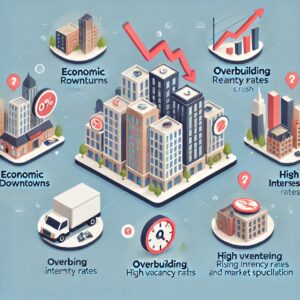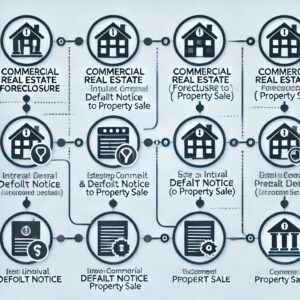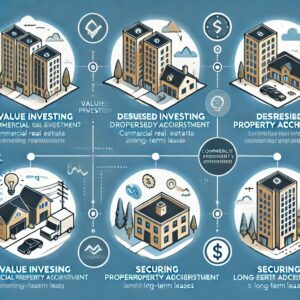Key Highlights
- The commercial real estate sector is facing major challenges, including declining asset values and tighter bank lending.
- The impending crash in the commercial real estate market has the to cause significant financial fallout.
- Remote work and the shift in office space demand are contributing factors to the current state of commercial real estate.
- Economic indicators are signaling trouble ahead for the commercial real estate sector.
- Small businesses and property owners are among those who will be most impacted by a commercial real estate crash.
- Investors can navigate the market by implementing risk management strategies and identifying investment opportunities in a declining market.
Introduction
The commercial real estate market is currently facing uncertainties, with various factors pointing towards a potential crash. Understanding the intricate dynamics at play is crucial for investors looking to navigate this challenging landscape. By analyzing historical trends and economic indicators, we can better prepare for the impact of a possible downturn. Stay informed about the key drivers influencing the commercial real estate sector to make well-informed decisions amidst this evolving market climate.
Understanding Commercial Real Estate Crashes
Definition and Causes
A commercial real estate crash involves a significant decline in property values, leading to financial losses. Contributing factors include:
- Economic Downturns: Reduced demand for commercial spaces.
- Overbuilding: Market saturation due to excessive construction.
- High Vacancy Rates: Prolonged periods of high vacancy devalue properties.
- Rising Interest Rates: Increased borrowing costs deter investments.
- Market Speculation: Unsustainable property value inflation due to speculative investments.
The Factors Leading to a Potential Crash
A combination of rising interest rates and shifts in demand due to remote work are key factors driving concerns of a commercial real estate crash. The Federal Reserve’s stance on interest rates influences borrowing costs, impacting property owners’ decisions. Changes in office space requirements as more companies embrace remote work could lead to a surplus in office properties, posing risks for the commercial real estate sector. These factors, if not managed effectively, may converge to create a challenging environment for the market, particularly for regional lenders who may not have adequately hedged against potential rate hikes.
Historical Context: Lessons from Past Crashes
During past commercial real estate crashes, overleveraging and speculative lending were common culprits. The 2008 financial crisis highlighted how interconnected financial systems could escalate the impact globally. Property owners often struggled with declining asset values and foreclosures surged. Regional banks faced significant losses due to a high concentration of commercial real estate loans, causing turmoil in the financial sector. Understanding these historical trends can provide valuable insights into mitigating risks and making informed decisions amidst uncertainties in the commercial real estate sector.
Historical Case Studies
Case Study 1: The 2008 Financial Crisis
The 2008 financial crisis severely impacted commercial real estate, teaching us important lessons about risk management, diversification, and regulatory oversight.
Case Study 2: The Dot-Com Bubble (2000-2002)
The dot-com bubble’s collapse affected commercial real estate, particularly in tech hubs. Key insights include the importance of understanding market dynamics and promoting sustainable growth strategies.
The Economic Indicators Signaling Trouble Ahead
The economic indicators signaling trouble ahead encompass rising interest rates and the evolving role of remote work in shaping office space demand. These factors are crucial in predicting the potential commercial real estate crash and policymakers must take them into account. Rising interest rates can impact borrowing costs and investment decisions, while remote work trends may reduce the need for traditional office properties, affecting the commercial real estate sector. Understanding these indicators is vital for investors to navigate the challenging terrain of the commercial real estate market.
Rising Interest Rates and Their Impact
Higher interest rates can have a profound effect on the commercial real estate sector. When the Federal Reserve raises rates, borrowing costs increase, making commercial real estate loans more expensive. This can lead to decreased demand for properties and potentially lower asset values. Many property owners who rely on loans may face challenges meeting their debt obligations, especially if they are forced to refinance with significantly higher interest rates. Additionally, rising interest rates could result in decreased investment and slower growth in the commercial real estate market.
The Role of Remote Work in Office Space Demand
The role of remote work in office space demand has shifted dramatically, with companies reevaluating their space needs as employees continue to work from home. This trend has caused a decrease in demand for traditional office properties, particularly in urban areas like New York City and San Francisco. This shift in demand is leading to an increase in vacancies for office buildings, even in major cities like Boston where up to 40% of buildings are currently vacant. Property owners and investors are closely monitoring these changes, anticipating a potential impact on commercial real estate values and rental rates. As remote work becomes more prevalent, the dynamics of the commercial real estate sector are undergoing a significant transformation.
Potential Consequences of a Commercial Real Estate Crash
Effects of a commercial real estate crash can vary for small versus large investors. Small investors may face liquidity issues, while larger investors might navigate the storm more easily. The broader economy would likely suffer, with job losses and reduced consumer spending. Property owners could experience declining asset values, impacting their overall financial stability. A crash could lead to a significant downturn in the commercial real estate sector, affecting businesses and communities reliant on its success.
Effects on Small vs. Large Investors
Small investors in commercial real estate may struggle with cash flow and face difficulties refinancing due to a crash, while large investors could capitalize on distressed assets. The commercial real estate crash may force small investors to offload properties at a loss or default on loans, impacting their financial stability significantly. Conversely, large investors with more robust financial backing may see the crash as an opportunity to acquire prime properties at reduced prices, potentially boosting their portfolios in the long run.
Implications for the Broader Economy
The implications of a commercial real estate crash extend beyond property owners and investors; they can reverberate throughout the broader economy. A sharp decline in the commercial real estate sector can lead to bank failures, impacting regional banks and smaller banks that specialize in commercial real estate loans. This could trigger a domino effect in the financial sector, affecting businesses that rely on loans and mortgages for their operations. Additionally, a downturn in commercial real estate can signal broader economic instability, causing ripple effects in various industries.
Navigating the Market: Strategies for Investors
Identifying opportunities during a declining commercial real estate market is crucial. Investors should focus on undervalued assets and diversification. Risk management becomes paramount during uncertain times; conducting in-depth research and due diligence is essential. Maintaining liquidity and flexibility in investment strategies is advised. Monitoring market trends and adapting quickly to changing conditions can provide a competitive edge. Additionally, seeking professional advice and staying informed about NLP terms can help investors navigate the volatile commercial real estate landscape successfully.
Proactive Measures
- Risk Assessment: Identify vulnerabilities in your portfolio.
- Diversification: Spread investments across various property types and locations.
- Liquidity Management: Maintain liquidity to handle financial obligations during downturns.
- Cost Management: Implement cost-saving measures to enhance financial stability.
Investment Strategies
- Value Investing: Focus on undervalued properties with strong long-term potential.
- Distressed Properties: Invest in properties available at a discount.
- Long-Term Leases: Secure leases with creditworthy tenants for stable cash flow.
Operational Strategies
- Tenant Retention: Improve services and offer competitive lease terms to retain tenants.
- Property Upgrades: Enhance property attractiveness and value.
- Market Analysis: Regularly analyze trends to make informed investment decisions.
Identifying Opportunities in a Declining Market
Look for distressed assets that have the potential for value appreciation in the long term. Consider diversifying your portfolio by exploring alternative real estate sectors with more stability during economic downturns. Keep an eye on properties in prime locations that are undervalued due to market conditions. Additionally, be prepared to negotiate favorable terms with motivated sellers looking to offload assets quickly. Adapting your investment strategy to capitalize on market fluctuations can lead to profitable opportunities amidst uncertainty.
Risk Management Techniques for Uncertain Times
When facing uncertain times in the commercial real estate market, implementing effective risk management techniques is crucial. Diversification of investments across different property types and locations can help mitigate risks. Maintaining a conservative loan-to-value ratio and ensuring sufficient cash reserves can provide a buffer during economic downturns. Conducting thorough due diligence before making any investment decisions is essential. Additionally, staying informed about market trends and working closely with experienced advisors can help navigate uncertainty with greater resilience. Utilizing these techniques can safeguard investments during turbulent times.
Case Studies: Winners and Losers in Previous Downturns
During previous downturns in the commercial real estate sector, there were clear winners and losers. Some investors who managed risk effectively and diversified their portfolios came out on top, showcasing the significance of prudent decision-making during turbulent times. On the contrary, those heavily exposed to high-risk assets or lacking in risk management strategies faced significant losses and challenges in recovering from the crash. Analyzing these case studies provides valuable insights for current investors preparing for a potential commercial real estate crash.
Success Stories: Investment Strategies That Paid Off
In the midst of the challenges facing the commercial real estate sector, there are success stories of investors who have navigated these difficulties and achieved impressive returns. These success stories highlight the importance of effective investment strategies and the potential for significant gains in the real estate market.
One such success story is that of Warren Buffett, who famously advises investors to be “greedy when others are fearful.” Buffett’s investment in office space in San Francisco serves as an example of his successful strategy. Despite warning investors that it could take a decade for prices to bounce back, Buffett has already secured funding and plans to purchase 3 million square feet of office space in the city at a significant discount. This marks the first time in almost two years that Buffett has made such a move, showing confidence in the market’s potential for growth.
Other investment firms, such as Ares Management and RXR, have also found success by purchasing interests in office spaces at discounted prices. These success stories demonstrate the potential for significant returns in the commercial real estate market, even amidst challenging conditions.
Cautionary Tales: Mistakes to Avoid
While success stories in the commercial real estate market are inspiring, it’s also important to learn from cautionary tales and avoid common investment mistakes. Real estate downturns can have severe financial consequences, and understanding the pitfalls can help investors protect their portfolios.
One cautionary tale comes from the experience of New York Community Bancorp (NYCB). In 2022, NYCB faced significant financial challenges, including a surprise quarterly loss and a sharp decline in stock prices. The lender’s struggles were attributed to exposure to troubled loans, highlighting the importance of thorough due diligence and risk assessment when investing in commercial real estate.
Another cautionary tale involves Silicon Valley Bank and other lenders that were hit by tidal waves of deposit withdrawals and ultimately seized by the federal government during the regional banking fiasco. These events underscore the need for lenders and investors to be prepared for potential financial crises and to carefully manage their portfolios to mitigate risks, including learning from the mistakes of banks like Signature Bank.
By learning from these cautionary tales and avoiding common investment mistakes, investors can better protect their portfolios and navigate the challenges of the commercial real estate market.
Conclusion
In conclusion, being prepared for potential shifts in the commercial real estate market is crucial for investors. Understanding the indicators and historical context can help navigate through uncertain times. Whether you are a small or large investor, having risk management strategies in place is essential. By learning from past case studies and success stories, investors can identify opportunities even in a declining market. Remember, staying informed and proactive is key to weathering any market downturn. If you have further questions or need guidance on navigating the commercial real estate landscape, feel free to get in touch with us.
Frequently Asked Questions
What Are the Signs of an Impending Commercial Real Estate Crash?
Signs of an impending commercial real estate crash can include declining asset values, higher interest rates, tightening bank lending, and market analysis indicating potential economic downturns. Warning indicators such as these can serve as early signals for investors to be cautious and take necessary precautions to protect their investments.
Is Now a Good Time to Invest in Commercial Real Estate?
Determining whether now is a good time to invest in commercial real estate depends on various factors, including market timing and current economic conditions. It’s crucial to seek investment advice, conduct thorough research, and consider the potential risks and rewards before making any investment decisions in the commercial real estate market.
How Can Investors Protect Their Portfolio from a Market Downturn?
Investors can protect their portfolios from a market downturn by diversifying their investments across different asset classes, conducting thorough due diligence, and staying informed about market trends and indicators. Implementing a strong investment protection strategy can help mitigate risks and safeguard investments in the event of a commercial real estate market downturn.
Could Government Interventions Prevent a Crash?
Government interventions can play a role in preventing a commercial real estate crash by implementing policy measures aimed at maintaining economic stability. These interventions can include measures to control interest rates, provide financial support to struggling businesses, and create regulations to prevent risky lending practices. However, the effectiveness of government interventions in preventing a crash ultimately depends on various factors and the specific circumstances of the market.




